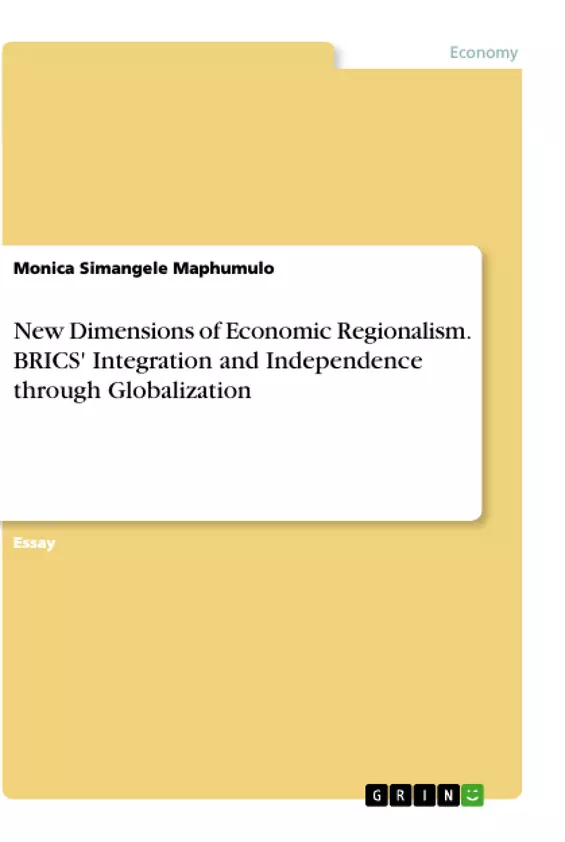The BRICS (Brazil, Russia, India, China, South Africa) are a fine example of explaining the new dimension of economic regionalism where BRICS’ intra-regional trade relations become the binding factor towards its economic integration and independence. The existing literature is focused on the economic integration of the five emerging countries, for example the economic integration theory (EIT) assumes that increasing globalization and technological progress leads to freer trade and movement of economic factors as well as to deeper integration over time. It shows that physical border is no longer a criterion for economic interdependence and integration within a group while the concerns and common interests form important factors for a new dimension of economic regionalism.
The concept of economic regionalism is defined as an empirically observable process of increasing cross-border activities, cooperation and coordination within a group of countries through integration. Originally, the concept of economic regionalism has been based on economic cooperation between natural partners (neighbouring countries or countries on the same continent). But since technological progress reduced transaction costs, intercontinental and global economic integration has become important in recent decades. Geographical distance may stay important for trade flows, but intercontinental relations of emerging countries record a steady rise in trade relations. In general, regionalism could be defined as preferential cooperation among nations that are relocated in terms of geographical proximity, with certain common characteristics such as historical, cultural, political and so forth. The objective of cooperation might be economic, political, or cultural in nature. In this context, the economic regionalism is considered more autonomous, outward-oriented, comprehensive and multi-dimensional process which includes trade and economic integration, environment and social policy issues relating to security and democracy, where the nation-states and other actors play an important role.
Inhaltsverzeichnis (Table of Contents)
- ABSTRACT
- PROLOGUE
- THEORIES ON ECONOMIC REGIONALISM
- Regional Integration theory
- Customs Union Theory
- BRICS AND OPEN REGIONALISM
Zielsetzung und Themenschwerpunkte (Objectives and Key Themes)
This paper examines the concept of open economic regionalism within the BRICS framework, highlighting its significance in the post-Cold War era. The paper investigates the increasing economic interdependence and integration among nation-states, particularly in light of the evolving landscape of regionalism.
- Economic regionalism and its evolving nature
- Theories of regional integration and their relevance to the BRICS context
- The role of BRICS in promoting open regionalism and its implications for global trade
- The significance of FDI and trade creation in BRICS economic integration
- The impact of open regionalism on developing countries and the global economy
Zusammenfassung der Kapitel (Chapter Summaries)
- ABSTRACT: This section introduces the concept of BRICS open economic regionalism, emphasizing its significance in the post-Cold War era. It highlights the economic interdependence and integration among BRICS nations, showcasing their contributions to global GDP and economic growth.
- PROLOGUE: This chapter delves into the concept of economic regionalism, outlining its evolution and defining it as a process of increasing cross-border activities, cooperation, and coordination within a group of countries. It further explains how technological advancements have influenced intercontinental and global economic integration, highlighting the rise of intercontinental trade relations among emerging countries.
- THEORIES ON ECONOMIC REGIONALISM: This chapter explores two key theories related to economic regionalism: Regional Integration Theory and Customs Union Theory. It analyzes functionalism, neo-functionalism, and Viner's customs union theory, explaining their key principles and how they relate to the BRICS context.
- BRICS AND OPEN REGIONALISM: This section focuses on the unique aspects of BRICS open regionalism, highlighting its key features and characteristics. It examines how the BRICS model differs from traditional forms of regionalism and its implications for global trade and development.
Schlüsselwörter (Keywords)
This paper focuses on key concepts such as economic regionalism, economic integration, economic interdependence, gross domestic product (GDP), regional integration, foreign direct investment (FDI), geographical proximity, and the multilateral system. It explores the evolving nature of economic regionalism, particularly within the context of BRICS nations.
- Quote paper
- Monica Simangele Maphumulo (Author), 2019, New Dimensions of Economic Regionalism. BRICS' Integration and Independence through Globalization, Munich, GRIN Verlag, https://www.grin.com/document/502144



